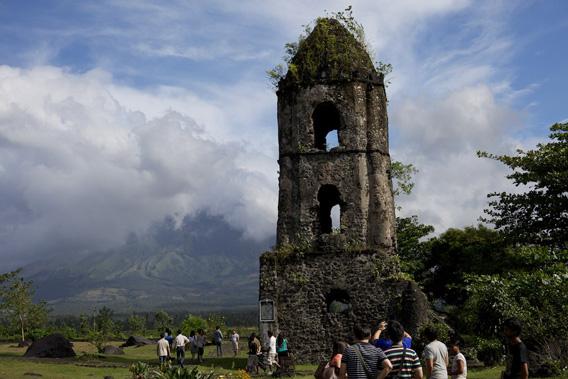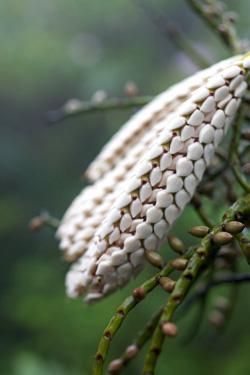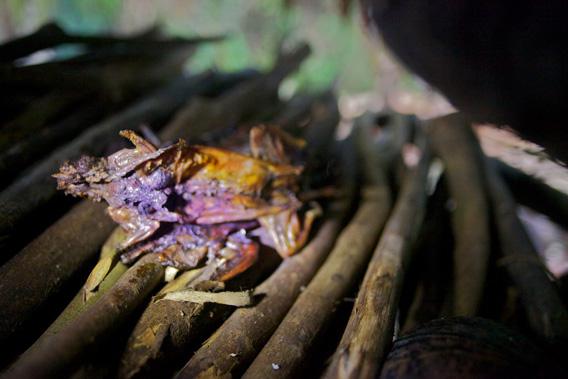MAYON—My driver, for the days before we hike up the volcano, is named Felimon Panesa. But his nickname, what most people call him, is “Boy.” Filipinos love nicknames. Everybody has one, and they range from the mundane—Junior and the like—to the bizarre, Dingdong or Ballsy. Felimon’s happens to be particularly awkward. I do what I can to avoid saying it out loud, and yet there I am, an American tourist in a former colony, calling out “Boy” across a church plaza and making demands of him from the back seat of an SUV. “Boy, can you take me somewhere for lunch?” “Boy, I’d like to go back to the hotel.”
Boy seems full of anger, ready to explode. He gets “extremely mad,” he tells me, whenever someone touches him. That’s why he doesn’t play basketball anymore. He’s also quit drinking—five years sober—and smoking and cockfights. Driving tourists works as a form of therapy. We cruise around Bicol in his vehicle, talking about basketball and listening to the Beatles anthology on repeat. When “Nowhere Man” comes on, Boy sings along in falsetto.
After a morning spent in consultation with tour guides in Legazpi, Boy takes me on a trip around the side of the mountain, to the centuries-old ruins of a church that once stood at the base of Mayon. On Feb. 1, 1814, the volcano sent a pyroclastic flow into the town of Casagawa. Those who’d taken shelter in the nave perished midworship—1,200 overall—and all that remains today is a set of crumbling, vine-covered walls of black rock surrounding a lonely steeple.

Photograph by Matt Elkind for Slate.
There aren’t many people around as I walk the barbed-wire perimeter of the church grounds, finding deposits of potato-chip wrappers, scrunched-up napkins, and empty beer bottles. There’s an abandoned spa next door, with concrete banquettes and a swimming pool scattered with bits of vegetation. The church ruins have apparently given way to a tourist attraction that was buried some years ago under a volcano of snacks.
Mayon looms in the distance, its crater draped in clouds. It reminds me of a bottle of local San Miguel beer, with the customary white napkin folded over its mouth. As I’m watching, another set of clouds crawls over the side of the mountain, sticking to it like strands of wet dough, then roping its way toward the church where I’m sitting. The mountain looks to be several miles away, but the clouds are soon over my head and I’m caught in a sprinkle of rain.
Now where did Boy get off to?
***
I spend a few hours that night tossing in bed, working out the odds. The chance of death is miniscule, of course—tourists go up the mountain every week, and then they come down. Yet it was only two years ago that the local government grew so frustrated with “hardheaded” adventure-seekers that it set up military checkpoints to keep them away. Would it matter—at all, to anyone—if I succeeded in climbing this mountain? Whatever the risks, the potential rewards seem just as small. I fall asleep imagining a fiery lahar bearing down on me from the crater, and the idea elicits more embarrassment than terror. What a stupid way to go.

Photograph by Matt Elkind for Slate.
Jo and his brother pick me up first thing in the morning, and we drive to the base of a farmer trail that wends up through jungle forest. On one side, a group of Filipinos are playing a makeshift game of pool using numbered glass tiles on a table dusted with baby powder. A little further on, we pass an older man in a Diesel T-shirt, shredding abaca bark to make twine. He’s got a fighting cock tied to a post, and a small fire smoldering beneath a bag of fish and a half-dozen splayed carcasses the size of Nerf footballs. We give him a few coins for a carcass—it looks like a smoked squab—and resume the hike.

Photograph by Matt Elkind for Slate.
The trail takes us up through stands of coconut palms and giant ferns, ringed betel nut trees and brush berries. At one point we come across a bush of carnivorous pitcher plants, hanging off their branches like inflated condoms. By noon we’ve climbed into a dense fog, and arrived at the clearing where, Jo tells us, we’ll spend the rest of the day and set up camp. If it weren’t for the total lack of visibility, he adds, we’d be treated to a sight of the stunning valley below. As he describes the spectacular view, I crane my neck and peer into the mist. I see the vague outline of a shrub.
We spend the rest of the day in camp, trying to stay dry under a tarp that’s not much bigger than a tablecloth. Jo and the porters get a fire going and, in the absence of anything else to do, begin an alternating service of instant coffee and full meals, offset by 15-minute refractory periods. By round three, I’m stuffed to the point of gastrointestinal distress and wired out of my mind on caffeine. That makes it all the more frustrating when I learn it will be another 12 hours before we can “assault the summit.”
There’s another tourist at the campsite, with another guide. Emma is a cute 30-year-old from Bath, England who used to sell Porsche sports cars and is now in the middle of an extended, around-the-world vacation. We don’t have much to say to one another but extreme isolation breeds a long and wide-ranging discussion. We chat about the number of people living in Bath, the work involved in selling fancy sports cars in Bath, and that one time she sold a sports car to Nicolas Cage in Bath. That exchange lasts about half an hour, leaving us with 11.5 more before it’s time to move on. Wait, how many people are there in Bath again?

Photograph by Matt Elkind for Slate.
Out of boredom more than hunger, Jo decides to cook up the squab-looking thing we’d picked up earlier in the day. “It’s kino,” he tells me—the Bicol word for rat. Kino is more appetizing than regular rat, he says, because it lives in the trees and subsists on fruits and berries. Like nearly every other foodstuff in the Philippines, the rodent flesh is prepared with garlic, vinegar, and instant Adobo seasoning mix. It does smell pretty good, but I lose my appetite when I realize that the tiny drumstick on my plate is actually a cartilaginous snout. (Later on, I’m grateful for having been so timid: The animal we ate turns out to be on the international Red List of Threatened Species; it’s called a giant slender-tailed cloud rat.)
After a long and noisy night spent under a mini-typhoon, we try our final ascent to the crater. The garden trek ends at the edge of a volcanic ash flow, where the thick vegetation has been carved away into a blackened canal running down the side of the mountain. Rainwater gushes by and the rocks look wet and slippery. There’s still a thick vapor around us, and my glasses get so fogged up that I have to check every step with a walking stick.
“From here, there’s a very nice view,” Jo says, gesturing excitedly at the gray blanket of nothingness that surrounds us on all sides. “You can see Tabaco city, and the ocean, and a beautiful sunrise.”
The path ahead seems treacherous even under dry conditions, but I’m hesitant to turn back. We’ve been on the trail for two days, and there’s been no sign of exploding magma or poison gas. With just a few more hours of climbing, we’ll be at the crater—peeking over the edge of the nation’s most frightening volcano.
But Jo won’t even consider it. “Too wet,” he says. “We’re going back down.”